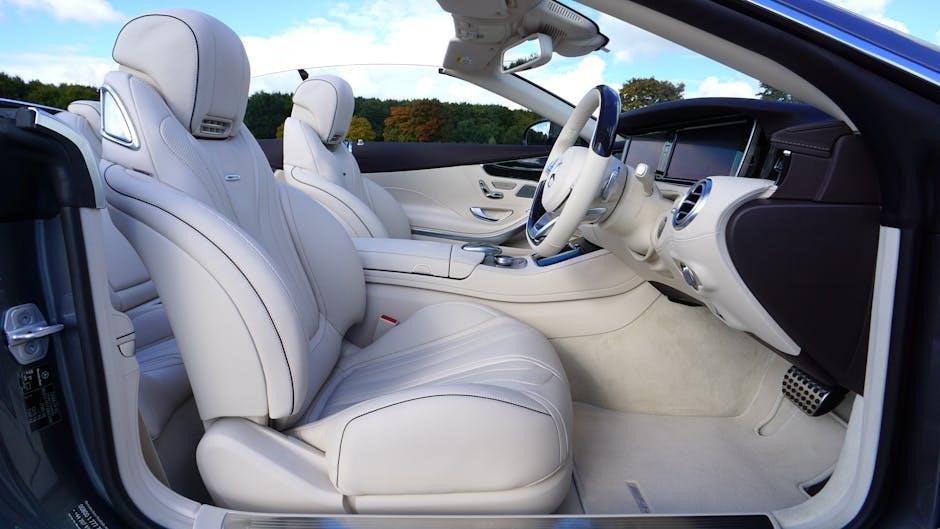Power steering offers ease and convenience, while manual steering provides a direct connection to the road. Choosing between them depends on driving style, vehicle type, and maintenance preferences.
Overview of Steering Systems
Steering systems are essential for controlling vehicle direction, with two primary types: power and manual. Power steering uses hydraulic or electric assistance to reduce driver effort, enhancing ease, especially at low speeds. Manual steering relies solely on the driver’s strength, offering a direct road feel. Both systems have distinct mechanisms, benefits, and drawbacks, catering to different driving preferences and needs. Understanding their differences helps drivers choose the most suitable option for their lifestyle and vehicle requirements.
Importance of Choosing the Right Steering System
Selecting the appropriate steering system significantly impacts driving comfort, safety, and overall vehicle performance. Power steering offers ease of maneuverability, reducing fatigue in urban driving, while manual steering provides a more connected driving experience, favored by enthusiasts. The choice influences maintenance needs, reliability, and cost. Aligning the steering system with driving habits and preferences ensures a better ownership experience, making it crucial to evaluate lifestyle and requirements before deciding between power and manual steering options.
Objective of the Article
This article aims to provide a comprehensive comparison between power and manual steering systems. By exploring their pros, cons, functionality, and maintenance requirements, it helps readers make informed decisions based on their driving needs. The objective is to clarify the differences, highlight key considerations, and offer recommendations to suit various preferences and lifestyles, ensuring drivers choose the most suitable steering system for their vehicles.

Pros and Cons of Power Steering
Power steering offers ease of maneuverability, reducing effort at low speeds and enhancing comfort. However, it is more complex, prone to failure, and requires regular maintenance.
Advantages of Power Steering
Power steering provides significant ease of use, especially at low speeds, reducing the effort needed to maneuver. It enhances comfort during long drives and in tight spaces like parking lots. The system offers smoother handling and better control, making it ideal for larger or heavier vehicles. Additionally, power steering reduces driver fatigue, allowing for a more relaxed driving experience. Its assistance is particularly beneficial in urban environments where frequent turning is required. Overall, it makes driving more accessible and less physically demanding for a wide range of drivers.
Disadvantages of Power Steering
Power steering systems are more complex and prone to mechanical failures compared to manual steering. They require regular maintenance, including fluid checks and potential repairs, which can be costly. Additionally, power steering systems are heavier and consume more energy, affecting fuel efficiency. In the event of system failure, steering becomes difficult, especially at low speeds. Furthermore, the added components increase the risk of leaks and electrical issues, making them less reliable in certain conditions. These factors can make power steering less desirable for some drivers seeking simplicity and durability.

Pros and Cons of Manual Steering
Manual steering is cost-effective and simple, offering a direct road feel. It’s more reliable but requires physical effort, making it challenging at low speeds and tiring on long drives.
Advantages of Manual Steering
Manual steering offers several benefits, including lower costs and simplicity. It requires fewer components, reducing maintenance needs and the risk of system failure. Drivers experience a more direct connection to the road, which is often preferred by purists and racers for better control and feedback. Additionally, manual steering is more reliable since it lacks complex mechanisms that can malfunction. This simplicity also means it’s less prone to mechanical issues, making it a durable choice for certain driving conditions and preferences.
Disadvantages of Manual Steering
Manual steering has notable drawbacks, primarily its demand for physical effort. It is significantly harder to maneuver at low speeds or when parking, requiring more strength and skill. This can be tiring on long drives, as the driver must constantly adjust the wheel without assistance. Additionally, manual steering lacks the ease and convenience offered by power steering, making it less accessible for drivers who prioritize comfort or have physical limitations. These challenges highlight why manual steering is less common in modern vehicles, which often favor power-assisted systems for everyday driving convenience.

How Power Steering Works
Power steering uses hydraulic or electric assistance to aid the driver, reducing effort needed to turn the wheels and making steering easier at all speeds.
Hydraulic Power Steering Mechanism
The hydraulic power steering mechanism relies on a pump driven by the engine to pressurize fluid, which assists the steering gear. This system reduces steering effort by providing additional force when the driver turns the wheel. It is commonly found in older vehicles and offers a smooth, consistent steering feel. However, it can be less efficient and heavier compared to electric systems, requiring regular fluid checks and maintenance to ensure optimal performance and reliability over time.
Electric Power Steering Mechanism
Electric power steering (EPS) uses an electric motor and sensors to assist steering. The system detects the driver’s input and applies the necessary force via the motor. EPS is lighter, more efficient, and requires less maintenance than hydraulic systems. It also offers features like adjustable steering effort and self-aligning torque. This mechanism is quieter, more precise, and reduces fuel consumption. EPS is widely used in modern vehicles due to its reliability and adaptability, making it a preferred choice for both everyday driving and advanced driver-assistance systems.

How Manual Steering Works
Manual steering relies on the driver’s physical effort to turn the wheels. It uses a steering wheel, shaft, gearbox, and linkage to transmit movement without assistance.
Basic Components of Manual Steering
Manual steering systems consist of a steering wheel, steering shaft, gearbox, and linkage. The steering wheel connects to the shaft, which transmits movement to the gearbox. The gearbox converts rotational motion into linear movement, directing it through the linkage to the wheels. This mechanical connection allows the driver to control the vehicle without hydraulic or electric assistance, relying solely on physical effort and mechanical advantage.
Functionality Without Assistance
Manual steering operates solely on the driver’s physical input, with no hydraulic or electric aid. This direct mechanical connection provides a more tactile driving experience, allowing the driver to feel the road intimately. While it demands more effort, especially at low speeds or during parking, manual steering is inherently simpler and more reliable, as it lacks complex components prone to failure. This simplicity appeals to driving purists and racers who value precision and a genuine connection to the vehicle’s handling and response.
Driving Experience Comparison
Power steering offers ease and convenience, reducing effort at low speeds, while manual steering provides a direct, tactile connection, appealing to purists and racers seeking precision and control.
Power Steering Driving Experience
Power steering delivers a smoother, more effortless driving experience, especially at low speeds or when parking. It reduces driver fatigue on long journeys and provides easier maneuverability in tight spaces. However, it can feel less connected to the road compared to manual steering. The system’s assistance makes steering lighter and more precise, but some drivers find it less engaging. Overall, power steering is ideal for urban driving and larger vehicles, offering comfort and convenience without sacrificing control.
Manual Steering Driving Experience
Manual steering offers a direct, tactile connection to the road, appealing to purists and racers. It requires more effort, especially at low speeds or when parking, which can be tiring on long drives. However, it provides better feedback and control, making it popular among enthusiasts. The lack of assistance demands more skill and strength but ensures reliability with fewer components prone to failure. For those who value a hands-on driving experience, manual steering delivers a more engaging and immersive feel behind the wheel.
Maintenance and Reliability
Manual steering systems are simpler and more reliable with fewer components, reducing maintenance needs. Power steering, while convenient, requires more upkeep and is prone to mechanical issues over time.
Maintenance Requirements for Power Steering
Power steering systems require regular maintenance to ensure optimal performance. Hydraulic systems need fluid level checks and inspections for leaks or worn hoses. Electric systems demand less upkeep but still require monitoring of sensors and motors. Both types benefit from periodic inspections of belts, pumps, and steering gears. Addressing issues early prevents costly repairs. Regular servicing ensures reliability and extends system lifespan, keeping the steering responsive and efficient over time.
Maintenance Requirements for Manual Steering
Manual steering systems are simpler and require less maintenance compared to power steering. Key areas to inspect include the steering box, linkage, and joints for wear or looseness. Lubrication of moving parts is essential to prevent friction and corrosion. Regular checks ensure smooth operation and prevent unexpected failures. With fewer components, manual systems are more reliable and easier to maintain, making them a cost-effective choice for drivers who prefer a straightforward, low-maintenance steering setup.

Cost Implications
Manual steering systems are generally cheaper to install and maintain due to fewer components. Power steering, while more convenient, involves higher initial and maintenance costs.
Cost of Power Steering Systems
Power steering systems are typically more expensive to install and maintain than manual steering. The cost includes components like hydraulic pumps, electric motors, and sensors. Maintenance costs rise due to potential failures in these parts, which may require specialized tools and expertise. While the upfront cost is higher, the convenience and ease of use often justify the investment for many drivers. Additionally, modern power steering systems, especially electric variants, may offer better fuel efficiency, potentially offsetting long-term costs.
Cost of Manual Steering Systems
Manual steering systems are generally more cost-effective than power steering. They require fewer components, reducing both initial and maintenance costs. With no hydraulic or electric assistance, manual systems are simpler and less prone to expensive repairs. However, the trade-off is the increased physical effort required for steering, especially at low speeds. For drivers prioritizing affordability and simplicity, manual steering offers a practical solution with lower long-term financial burdens, making it a viable option for those who value cost efficiency over convenience.

Modern Advancements in Steering Systems
Modern steering systems integrate advanced technologies like adaptive steering and semi-autonomous features, enhancing driver control and comfort while maintaining the essence of power and manual steering principles.
Hybrid Steering Systems
Hybrid steering systems combine the benefits of power and manual steering, offering adaptive assistance based on driving conditions; These systems use advanced sensors and motors to provide electric assistance at low speeds and transition to manual control at higher speeds, optimizing both ease and driver engagement. Hybrid systems are designed to enhance fuel efficiency and reduce mechanical complexity, making them ideal for modern vehicles that require versatility and performance. They represent a balanced approach, catering to diverse driving needs while maintaining reliability and responsiveness.
Future Trends in Steering Technology
Future steering systems are expected to integrate advanced technologies like autonomous driving and adaptive assistance; Steer-by-wire systems will replace mechanical connections with electronic signals, enhancing safety and efficiency. Electric power steering will become more prevalent, offering customizable settings and energy efficiency. Autonomous vehicles will rely on sophisticated steering systems for self-driving modes. These innovations aim to improve safety, comfort, and driving precision while reducing mechanical complexity. The evolution of steering technology will cater to both everyday drivers and enthusiasts, ensuring a seamless transition between manual and autonomous control.
Power and manual steering each offer unique benefits, with power steering excelling in convenience and manual in driver connection. The choice depends on personal preference and driving needs.
Final Thoughts on Power vs Manual Steering
The choice between power and manual steering hinges on convenience, driving style, and vehicle use. Power steering offers ease, especially in tight spaces, while manual steering provides a direct road feel. Manual systems are simpler, cheaper, and more reliable but require more effort. Power steering, though more complex, reduces driver fatigue. Consider your priorities: ease of use or a connected driving experience. Both systems have their place, so weigh your needs carefully to make the best decision for your driving habits and vehicle type.
Recommendations Based on Driving Needs
For city driving or low-speed maneuvers, power steering is ideal due to its ease of use and reduced effort. Drivers of larger vehicles or those prioritizing comfort should opt for power steering. Manual steering suits purists, racers, or those seeking a direct road feel. Budget-conscious drivers may prefer manual steering for its lower cost and simplicity. Ultimately, choose based on your driving habits, vehicle type, and personal preference for convenience or connectivity. Consider your lifestyle and needs to decide which system aligns best with your daily driving experiences.

